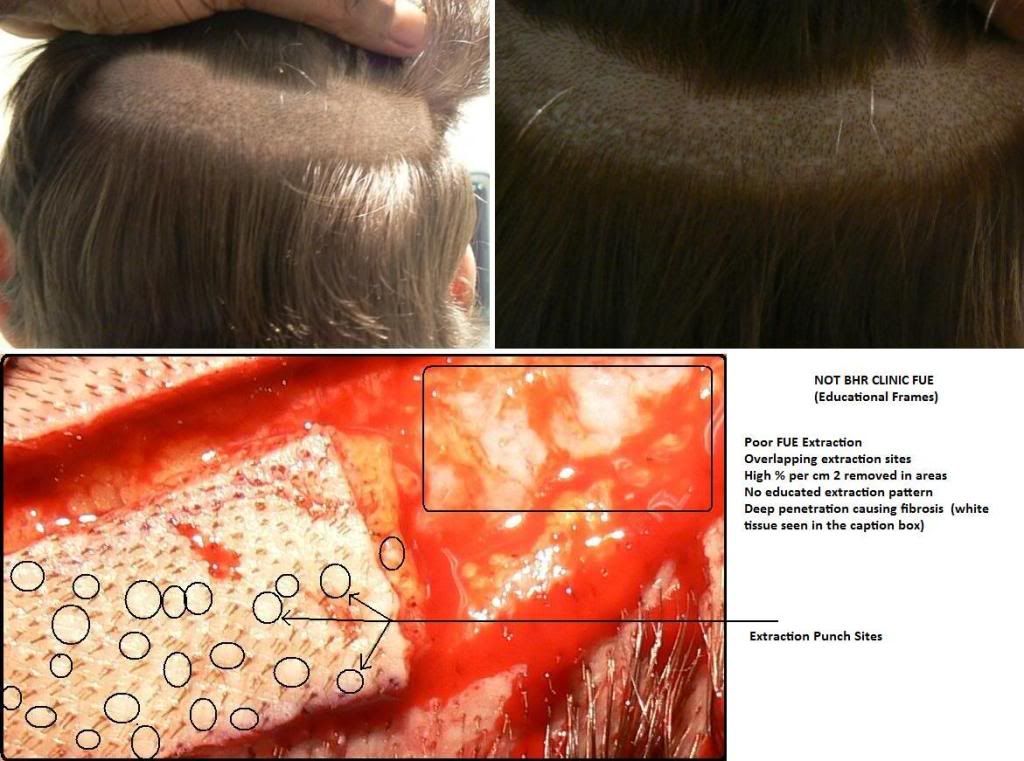FUE is generally considered suited to smaller procedures, opening the donor surface area after multiple strip procedures or in repair cases when the donor has little laxity or multiple scarring from previous poor procedures. Larger FUE sessions are possible but in a smaller % of HT candidates because the follicular units available will be less if you stick to an educated extraction pattern and only up to 30% harvesting per cm2.
A Strip procedure will change the laxity of the donor as most are well aware, so can FUE if not performed well. Although FUE is a single punch extraction the technique, tool size, surface area harvested and extraction pattern can have just as detrimental effects on the laxity when looking at future procedures.
The technique is something that is learnt and a talent, knowing the variants in skin textures, healing of different skin types, the splay of the hair within the scalp, how the exit point of the hair can be deceiving on where the hair angle lies within the skin. The “touch” of the doctor to be able to “feel” the FU is something that comes with time. For example a mechanical drill type tool maybe quicker and more efficient in terms of speed but it will carry no natural feeling between you and the skin, may it even jumps/slides slightly when entering the skin causing greater scarring and can be harder to control depth. Even by hand if the extraction is taken too deep it will cause unnecessary fibrosis under the skin surface and this will affect the laxity longer term.
Tool size has an obvious factor, the larger the size the more likely to leave larger “hair less areas”, more skin tissue is removed and therefore wider peripheral trauma to the surrounding skin and FU’s; this could in the future reduce the potential numbers further, changing the skin elasticity.
The surface area and extraction pattern; many like the idea of partial shaving, especially when the number of grafts is under 1000, it seems an ideal way to have FUE if you can hide the extraction area under the surrounding hair while it grows back. The problem arises when a minimal area of extraction is targeted, be it a long band shaved or a larger “box” like area shaved. Firstly the area chosen to harvest will probably be the area of highest density in the donor, hence being able to over harvest bit not make a great impact change on the density compared to the surrounding slightly lower density areas. This will impact future procedures, especially if a Strip is required because the area may have lost 40% plus of the FU it had reducing the Strip numbers and making the extraction from the Strip harder having to cut the FU out around the surrounding scar tissue. Then the laxity changes in a smaller area if over harvested, maybe not obviously to the touch but certainly when again trying to extract later, be it with either technique.
Another problem with partial shaving is long term always, never short term; the likelihood is the total number of FU available will be reduced if a continued partial shaving protocol is followed. Moving from one area to the other with slightly different hair characteristics and different size hair groupings as you move around the scalp slightly defeats one of the true benefits of FUE, being able to open the donor surface area up to it’s widest possible point and determine the FU total then with an educated extraction pattern remove over the entire area. This will have the least impact on the density of the donor, cosmetically more pleasing if the hair is kept short, and from a long term aspect causes minimum trauma to the donor as a whole because the extraction is spread not localised in a small condensed area. Condensing the area will not just effect that area, it is like throwing a stone into water and the ripples move outwards, the effects spread; the smaller the stone less impact the larger the stone the greater surface impact and peripheral impact, so minimising the impact by spreading the extraction points as far as possible will only preserve your donor and minimise the trauma.



